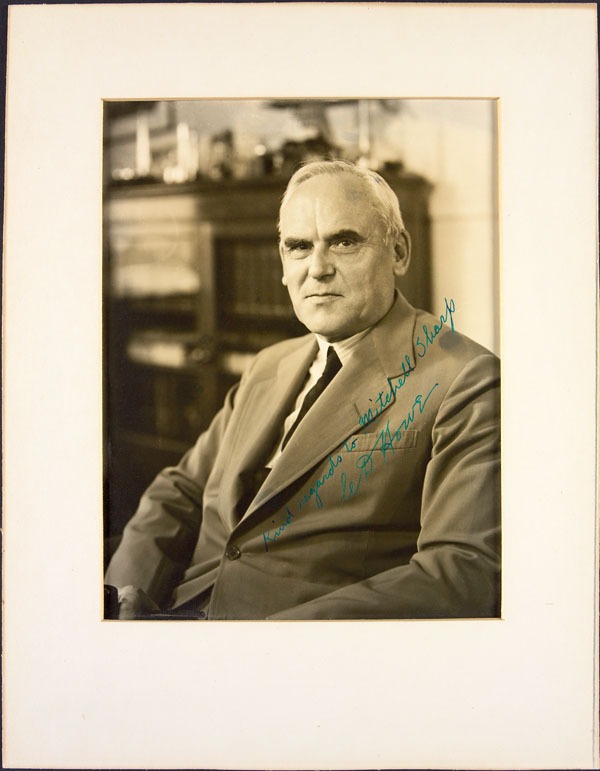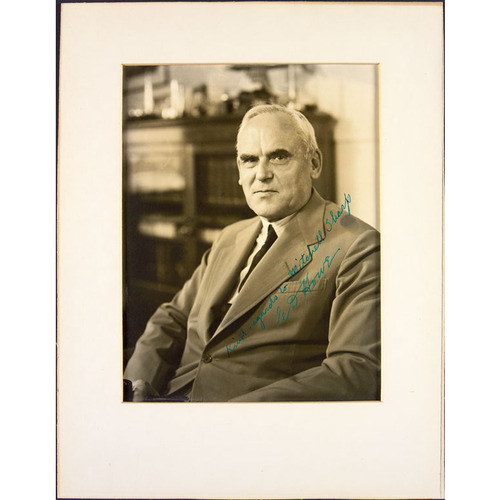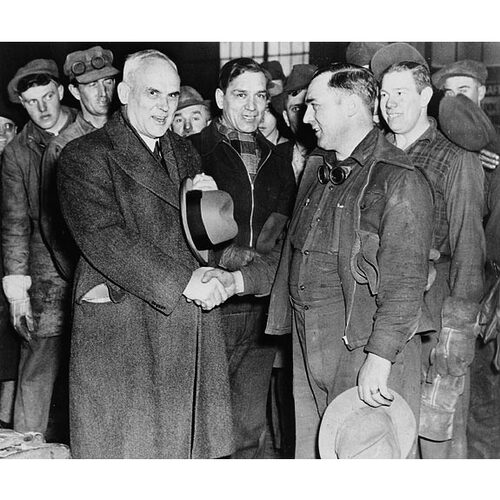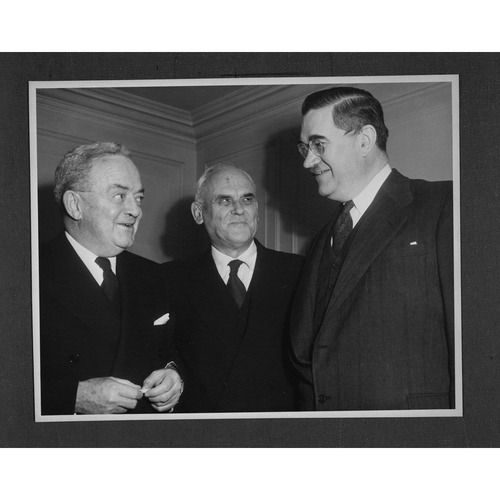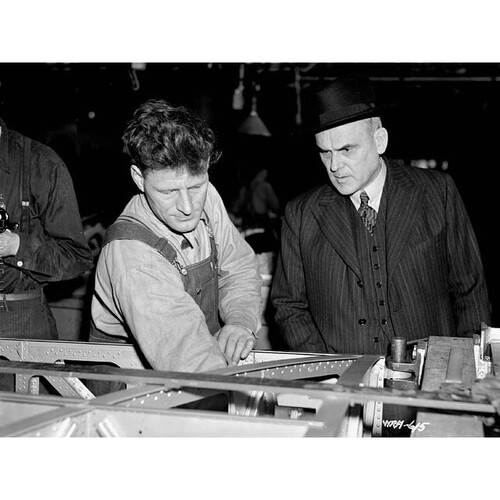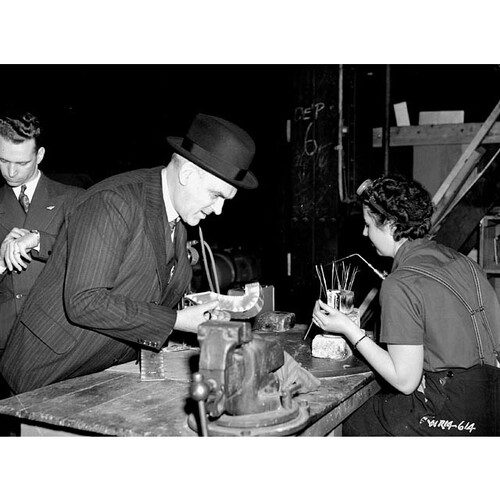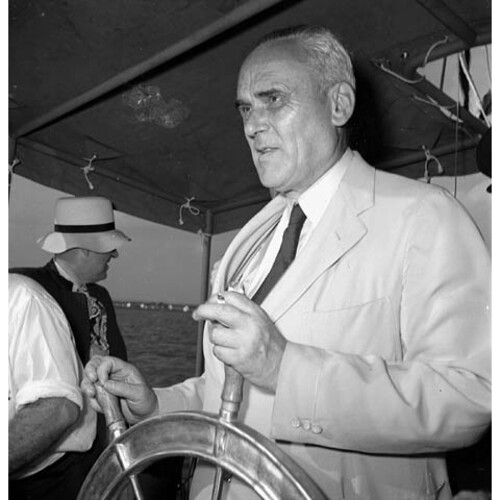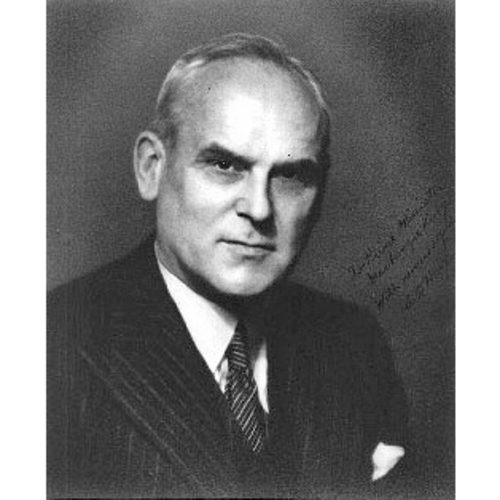HOWE, CLARENCE DECATUR, engineer, professor, civil servant, businessman, and politician; b. 15 Jan. 1886 in Waltham, Mass., only son of William Clarence Howe and Mary Hastings; m. there 16 Sept. 1916 Alice Martha Worcester, and they had two sons and three daughters; d. 31 Dec. 1960 in Montreal.
Clarence Decatur Howe’s ancestors were among the original Puritan settlers of Massachusetts in the 1630s. His connections on his father’s side included Julia Ward Howe, author of “The battle hymn of the Republic,” and Joseph Howe*, the tribune of Nova Scotia; one of his mother’s relatives was Stephen Decatur, the American naval hero, after whom he was named. The Howe family, though locally prominent, was far from rich. Howe attended public schools in Waltham, and then the Massachusetts Institute of Technology in Boston, graduating with an engineering degree near the top of his class in 1907. He had a reputation among his classmates for being bright, energetic, efficient – and lucky. He needed the luck, because there was a sharp recession in 1907–8 and work was scarce. Fortunately, one of his professors, George Fillmore Swain, received a letter from Dalhousie University in Halifax asking him to recommend someone to teach civil engineering. Howe accepted the possibility of advancement and adventure.
He arrived in Canada in 1908, just in time to supervise the engineering summer camp. At 22 he was barely older than his senior students, but as early as that August, one recalled, “we had acquired a great respect for him.” What impressed them was his refusal to pretend to knowledge he did not have, and his ability to reason through a difficulty. “The engineer,” Howe later said, “deals with concrete problems, where facts are facts and all else is error.... There is no devious route to the correct answer.” Engineering was “hard facts and hard practice.”
Howe enjoyed the life of a professor, and he liked Halifax. He would have been inclined to stay an academic in Nova Scotia except for the provincial government’s decision to centralize senior engineering instruction at the new Nova Scotia Technical College [see Alexander Howard MacKay*]. Losing his senior students removed much of the enjoyment he found in teaching, and it made him receptive to an unexpected offer.
A colleague at Dalhousie, Robert Magill*, had been made chairman of the Board of Grain Commissioners, recently created by Prime Minister Robert Laird Borden*’s government and headquartered in Fort William (Thunder Bay), Ont. An agency was needed to manage the gigantic grain trade – in 1913 Canada’s wheat exports were second only to those of the United States, and not second by much. Yet the infrastructure to handle wheat was vastly inferior to the ability of the prairie settlers to produce it. Magill soon decided that his board should intervene directly in the trade, and therefore it needed its own grain elevators. This conclusion called for an engineer, and who better than his friend at Dalhousie? In 1913 Howe took three momentous decisions: he resigned from the university, he entered the federal civil service, and he became a British subject. His future was not in academia, but it was in Canada, and in Canada he would stay.
He arrived in Fort William at the right moment to take advantage of a revolution in the design and construction of grain terminals, which were being arrayed in banks of cylindrical towers in ports from Vancouver to Montreal. He travelled across the west, learning about the country and acquiring new points of reference in his exploration of Canada – the prairies, and the railways and ports that serviced the grain trade. While siting his elevators, Howe got to know the farmers’ organizations and the heads of the various grain companies; equally important, they got to know him, and liked what they saw. Plain and direct in explaining his business, he never talked down to the grain suppliers, adopting the same approach he had used with his students. Building elevators was of vital interest to businessmen, politicians, and the farmer-voters of the three prairie provinces. Understanding grain was a key, perhaps the key, to understanding how the west functioned, not merely economically, but politically.
Howe’s elevators were built just in time. World War I drove up demand for wheat among the Allies and Canada became a major supplier, with a system of storage sites and transportation links that efficiently moved grain to eastern ports for shipment to Europe. The price rose with demand, and Howe saw another opportunity. Resigning from the Board of Grain Commissioners in 1916, he formed C. D. Howe and Company, in partnership with Ralph Borthwick Chandler, to build elevators.
The other great event in Howe’s life that year was marriage to Alice Worcester, whom he had known when he worked during summers for her father, Joseph, in Waltham. The two set up house not in Fort William, but in its smaller neighbour, Port Arthur (Thunder Bay), along the swampy shore of Thunder Bay on Lake Superior. It was a logical economic decision. The price of property in Fort William, which monopolized the grain terminal business at the head of the Great Lakes, was too high, in Howe’s opinion. Port Arthur had land for the huge terminals he wanted to build, and in the fall his company started work there on a project for the Saskatchewan Grain Growers’ Association.
For Alice it was not just another country, it was another world, remote and isolated, but very busy. Resourceful and decisive, she made the best of it, as she had to: his profession often took her husband away for weeks, sometimes months. There is a family story of a day, probably in the late 1920s, when Howe returned home from a trip and was gravely escorted into the living room by his wife, who announced, “Children, I’d like you to meet your father. You may not remember him.” The Howes had a remarkably stable and generally equable relationship that lasted over 40 years, but roles and responsibilities were firmly divided: Alice raised the children and ran the household, while Clarence, earning a living, was absent in more ways than one.
The end of the war meant an expansion of Howe’s business. The Canadian grain trade remained its core and the Lakehead its centre, but during the 1920s the Howe Company built elevators in locations as far away as Great Britain and Argentina. The architect Le Corbusier praised the shape of the grain elevator as the quintessential modern building, and he may (or may not) have had Howe’s constructions in mind. By 1929 his firm was known for creating better elevators faster and cheaper than its rivals could do. It was probably the foremost designer of grain elevators in the world, and its prospects seemed unlimited.
The company was unprepared for the abrupt fall in the price of wheat towards the end of the decade. Initially, it did not matter very much since there was an accumulation of elevator projects, some of which would not be finished until 1933. But wheat prices did not recover, and those of other primary or semi-manufactured products, such as lumber and pulp and paper, also fell. These declines were important factors in the Great Depression, and help explain why western Canada and northern Ontario, especially the former, were hit particularly hard.
By 1934 Howe’s firm was down on its luck. Professionally, the staff consisted of Howe and one junior engineer, John Murray Fleming, and the business dealt mostly with insurance appraisals. Despite some unwise investments in, for example, Peruvian bonds, he was personally financially secure, but his company’s prospects were distinctly limited. He was disturbed by the failure of governments to chart a way through the depression; from this concern it was only a step to considering what he as an individual could do about it. His work had always been linked to politics and political figures. Grain and grain marketing were highly charged topics in the west, and much prairie politics turned on grain, or the railways to transport it, or the money to capitalize it. He was friendly with members of both the Conservative and the Liberal parties, but although he had served on the Port Arthur school board from 1921 to 1925, he did not, before 1934, admit to a partisan identification.
The Liberals acted first. Under William Lyon Mackenzie King*, they were in federal opposition, with consequently more freedom than Prime Minister Richard Bedford Bennett*’s Conservatives to choose candidates who were potential cabinet ministers. (Robert James Manion*, in neighbouring Fort William, was minister of railways and canals.) Norman Platt Lambert*, the Liberal Party’s national organizer, was a veteran of the grain business and an old acquaintance of Howe’s. While travelling through Port Arthur in April 1933, he called on the Howes one night after dinner, and this visit eventually led to a meeting with King in Ottawa on 20 Jan. 1934. Howe made it plain that if he were to enter politics as a Liberal and his party were victorious, he would not want to waste his time on the back benches. As Lambert told his diary, “Howe’s approach to running in Port Arthur seems to be a desire for a guaranteed cabinet position!” In the election called for 14 Oct. 1935 the Liberal chances of victory were extremely good: the Conservative government’s failed attempts to counter the effects of the depression had made it deeply unpopular.
Howe was successful in Port Arthur; nationally, the Liberals won 173 out of 245 seats. King had plenty of material from which to form a cabinet, but also plenty of obligations to meet and expectations to satisfy. Most of those chosen were political veterans; some, Ernest Lapointe* and Charles Avery Dunning among them, were alumni of earlier Liberal cabinets. Others, such as Charles (Chubby) Gavan Power*, would be assuming their first ministerial post. King had to balance Ontario interests; in the end he selected Howe to head the ministries of marine and of railways and canals, pending their amalgamation into a new department of transport. Port Arthur was too far from Ottawa to allow for regular weekend commuting, and in any case his duties would not permit frequent travel from the capital. The Howes bought an expensive house in the suburb of Rockcliffe Park, and there, for the next 22 years, they stayed. The children would be sent to various private and public schools. There was one other transfer from Port Arthur to Ottawa: Howe hired a brash but intelligent and efficient young man named William John Bennett*, who had worked on his election campaign, to be his private secretary, the head of his tiny office, and the gatekeeper. It would prove a fortunate appointment: Bennett was good at his job, and was an important reason why Howe was good at his.
The new minister’s legislative docket was full. In forming his new department he had to resolve the difficult political question of the administration of Canada’s ports and harbours, a system fraught with patronage. Local Liberals naturally favoured autonomy for the various harbour commissions; reformers preferred centralization as the best way to deter corruption. He took the side of reform, and had to face down a storm of indignation from the Conservatives as well as his fellow Liberals. Next, Howe had to manage the creation of two new crown corporations to deal with technological advances of the 20th century: air travel and radio broadcasting. The age of commercial aviation was just dawning, but in a country like Canada, with its vast distances and small population, the economics were discouraging. He initially proposed a public-private mix to create a Canadian airline, a partnership between the federally owned Canadian National Railways and the privately run Canadian Pacific Railway. The government would provide the operating capital, which, in Howe’s view, entitled the government and the CNR to a majority of the seats on the proposed board of directors. Sir Edward Wentworth Beatty* of the CPR baulked, as did James Armstrong Richardson* of Winnipeg’s Canadian Airways. Both felt that their companies had been short-changed by the minister’s decisions. Howe proceeded to set up, in April 1937, a wholly government-owned company, Trans-Canada Air Lines. Accompanied by Herbert James Symington*, who would become TCA’s president in 1941, Howe inaugurated the new airline by taking a gruelling flight from Montreal to Vancouver on 30 July. It was not an event that could be lightly repeated, but it was a harbinger of things to come in aviation. Shortly before the trip, broadcasting had been regulated and the government’s existing radio activities consolidated into the Canadian Broadcasting Corporation. In these latter achievements Howe played a small but important role by helping to choose the executives; the enabling legislation was largely the work of other hands.
The King administration was lucky that, by 1935, the economy was starting to regain strength. Yet, despite some hopeful signs, the government had to bail out most of the provinces, some of which would have faced bankruptcy because of large welfare expenditures and declining tax revenues. Unemployment remained stubbornly high, and commodity prices – that of wheat, for example – took a very long time to recover from the effects of the depression. To add to the difficulties, the government had to consider how it would finance a more and more probable war.
It was clear by 1938 that a conflict between Great Britain and Germany was likely. King and his ministers supported the British policy of appeasing Germany. King had to take account of public opinion, divided between English and French, and poisoned by the conscription crisis during World War I [see Arthur Meighen]. Since then Quebec had opposed Canadian involvement in European war, but a worsening international situation and the growing danger posed by a belligerent, rearmed Germany alarmed many. King understood that if Britain went to war, English Canada would irresistibly favour participation; equally important, Lapointe, the most powerful political figure in Quebec, understood it too. The result was a compromise, generally accepted in 1939 among leaders of all parties: Canada would respond to German aggression and British danger, but there would be no conscription for overseas service. On this basis, when Germany attacked Poland and Britain declared war, Canada entered the struggle on 10 September.
Howe believed that fighting was inevitable, and he recommended that Canada ready itself to put all its resources into the war effort. No one was quite sure what such an undertaking would mean, but to prepare for the worst the government passed a bill on 13 September to create a department of supply. Its provisions were not immediately implemented because it was not clear what supplies would be needed. Britain would be the principal customer, but its government, facing serious financial problems, was reluctant to say what or how much it would buy. A supply mission to Canada was slow to act, leading Howe to conclude that British manufacturers did not want Canadian competition. The War Supply Board, established on 15 September, dragged on under the uninspired leadership of automobile executive Wallace Ronald Campbell. After the German army swiftly conquered Poland, the war entered a quiescent phase, the period of the so-called phoney war.
Howe continued as minister of transport through the winter of 1939–40, and participated as the regional minister for northern Ontario in the general election of March 1940. The result was another triumph for King and the Liberals, exceeding the 1935 victory in both the percentage of the popular vote and the total number of seats. King needed the support: the war ceased to be phoney when the Germans attacked Denmark and Norway on 9 April, and, on 10 May, the Low Countries, and then France. On 9 April the supply act passed the previous September was proclaimed. The Department of Munitions and Supply was established, and Howe was named minister. In later years he would be considered the inevitable, the appropriate, choice to run Canada’s industrial war effort. It did not seem so at the time. The Liberals were unpopular among the business elites in Montreal, Toronto, Winnipeg, and Vancouver. Howe might be known in the grain trade, but his was not a name to conjure with on St James (Saint-Jacques) Street or Bay Street, where it was felt that the business of war required leadership from businessmen.
The new minister was fortunate to find waiting for him at the War Supply Board three outstanding men: Henry Borden, a prominent Toronto corporate lawyer who was medically unfit for combat; Robert Alexander Cecil (Red) Henry*, a former federal deputy minister of railways and canals; and Gordon Wallace Scott, a well-known Montreal businessman. They were transformed into an unofficial executive committee, and to their number, on Borden’s recommendation, was added Edward Plunkett Taylor*, an extremely active if somewhat unscrupulous Toronto financier. Under Howe, the department functioned more like a large corporation than a government body. Its executives were business veterans, not civil servants, and most agreed to work in Ottawa for the nominal pay of a dollar, becoming known as “dollar-a-year men.” (Their original firms generally paid their salaries.) The department’s powers were vast. Howe could do virtually anything he wanted in the interest of the war, including seizing private property, diverting necessary materials from civilian use to war production, and altering contracts. Broadly, his tasks were to regulate scarce materials and generate war supplies, and therefore the department was divided between controls, headed by Borden, and production, eventually run by Harry John Carmichael*, who was brought in from General Motors of Canada.
The war news in the spring of 1940 was desperate. The Germans conquered the Low Countries in May, and France in June. The British retrieved most of their army from Dunkirk, but lost most of their equipment. They needed all the supplies they could get, and Howe proposed to provide them. It did not matter, he told his executive committee at the end of June, that there were no firm orders as yet. They should proceed as if there were. As Borden remembered Howe’s words, “Before the war is over everything will be needed so let’s go ahead anyway. If we lose the war nothing will matter.... If we win the war the cost will still have been of no consequence and will have been forgotten.”
Howe had already altered his department’s structure, making it less hierarchical and more reliant on individual initiative. In June 1940 he did more, using his powers to establish new crown corporations to buy supplies and create goods. The first three dealt in silk (used for parachutes), rubber, and machine tools – all scarce, and all bought outside the country. Then Howe moved to ensure that his department alone would handle supplies destined for Canada’s allies. By March 1942 all lines of contact would pass through his ministry, an arrangement in force until the war’s end.
Not everything proceeded smoothly. The American minister to Canada, Jay Pierrepont Moffat, compared Howe to the ringmaster of “a thirty ring circus,” and while the spectacle was admirable, slip-ups were inevitable: for example, there were problems in aircraft production due to conflicting information and unclear priorities. The government’s financial advisers became alarmed by the drain on Canada’s scarce foreign exchange reserves caused by purchases of essential equipment in the United States. In the fall the Wartime Requirements Board was created for the purpose of examining the department’s expenditures. Harvey Reginald MacMillan*, a Vancouver-based lumber magnate appointed to head the board, was used to getting his own way, and he disapproved of Howe’s often haphazard methods. He let it be known that he thought he could do better. Howe chose this moment to go overseas to deal directly with his British customers. He sailed out of New York on 6 December, and his ship, the Western Prince, was torpedoed by a German U-boat on the night of the 13th. Scott, who was travelling with the minister, was lost, but Howe was rescued and proceeded to London. When he returned in January he found that his exploit had done him no harm politically; however, a major crisis had erupted out of MacMillan’s charges of sloppy management.
Howe was frequently regarded by his contemporaries as a rather clumsy politician, yet now, when his career was at stake, he demonstrated considerable skill and real insight in dealing with King, the only man whose opinion counted. He persuaded the prime minister and other cabinet members that his department was not badly administered and that there were no lurking scandals that could damage the government. Then, on 26 Feb. 1941, he defended MacMillan in the House of Commons, declaring that, since MacMillan had taken an oath of secrecy, he could not possibly be the source of gossip or rumours. It was also pointed out that MacMillan had retailed his complaints of maladministration to political enemies. King concluded that MacMillan was “a traitor, by violating his oath of secrecy, and a conspirator and a cat’s paw in the hands of those playing a Tory game.” Howe sailed serenely above it all. He told MacMillan to head up shipbuilding in Montreal – take it or leave it. MacMillan took it, swallowed his complaints, and later in life praised Howe as “the greatest organizer Canada has ever seen.” There were no further eruptions from munitions and supply. The department’s Conservatives, such as Borden, admired the minister, supported his work, and insulated him from the official opposition. This loyalty was based in part on the fact that, philosophically, there was little difference between him and his business appointees.
In his dealings with labour, Howe was less fortunate. Accustomed to the traditionally minded, politically centrist craft unions, he was unprepared for the industrial unions that dominated the large factories of central Canada. He was even more unprepared for unofficial labour movements of the kind that shut down the plant of the Aluminium Company of Canada in Arvida (Saguenay), Que., beginning in July 1941. Work stoppage of any duration would mean that the smelting pots at the factory would freeze, requiring costly, time-consuming repairs and interrupting an important component of the national war effort. That fact counted with Howe; for the rest, he listened to wild tales spun by company executives featuring purported enemy aliens leading gullible French Canadian workers onto the picket lines. Howe demanded that the army be sent in; otherwise, he would resign. Justice minister Lapointe refused, telling King that “Howe has allowed himself to be deceived by the Alumin[i]um Company” about a situation that had really been precipitated by bad management and poor communication. Howe did not resign, though he came close, and he may have learned something from the experience, for he did not repeat the threat for the duration of the war (in January 1946 he would be irritated enough to hint at resignation during a dispute with King). Both he and his department’s officials would gradually alter their attitude towards organized labour. Union representatives would find their way onto the boards of crown corporations that reported to Howe, and his relations with unions would become, at worst, polite. The overriding considerations were that war production must be uninterrupted, and Canada’s reputation as a reliable supplier to its own forces and to its allies must be maintained.
Attention to the needs of French Canadians was crucial to King’s government, whose members did not have to be reminded of the damage wrought by the conscription crisis of 1917–18. French was not among the subjects Howe had studied after high school, and his experience at Dalhousie and in the grain trade had not exposed him to many French-speakers. He respected Lapointe, though the two were not close. After Lapointe died in November 1941, King replaced him as minister of justice with Louis-Stephen St-Laurent*, whom Howe grew to admire and respect for his decisiveness and good judgement. King was soon using St-Laurent when he needed to make a case to Howe, as, for example, when he wished Howe to take on responsibility for post-war reconstruction in 1944.
The ability to supply allies was an important asset in Canada’s dealings with both the United States and Great Britain. Canada relied on the United States for materials ranging from oil to iron ore to machine tools; in return, Canada provided products not readily available south of the border. This situation was central to a problem that was resolved during the winter of 1941. Canada required American dollars to buy supplies in the United States that would be converted into arms for Great Britain. The British did not have the money to pay for the arms except through the terms of the Americans’ Lend-Lease Bill. Howe believed that Canadian dependence on lend-lease would be economically disadvantageous. Instead, he and William Clifford Clark, the deputy minister of finance, negotiated American access to Canada’s products on a reciprocal basis, and opened the way for Britain to spend its American currency to buy supplies to be used in Canada. This complicated package was then ratified by King and President Franklin Delano Roosevelt as the Hyde Park Agreement on 9 April 1941. With minor modifications it kept Canadian war finance and production on an even keel.
Howe’s success depended on an adequate labour force, which proved more and more difficult to maintain as the war dragged on. Full employment was achieved as early as October 1941; however, there were clashing commitments. Canada wished to field a large army in addition to an air force and navy, but as the third-ranking industrial power among the Allies, it also had to staff its munitions factories. Howe had mixed feelings when, in 1942, the question of conscription for overseas service arose. He approved of the commitment in theory, but in practice wanted more workers at home rather than more soldiers abroad. Inevitably, he argued with Minister of National Defence James Layton Ralston*. In October 1944, when conscription again became an issue and threatened to alienate French Canada, Howe agreed with most of his English-speaking colleagues that it was urgent to send reinforcements to the country’s battered army in Europe. Yet he was not a leader among the pro-conscription ministers, and was greatly relieved when “the old man,” as he called King, managed a compromise by delaying conscription until the need for replacement troops had declined.
By late 1944 the war was winding down, and politicians had begun to contemplate what the world and Canada would be like after its end. The general opinion was that depression would return. Such a situation would require careful management and extensive government intervention – in effect, a continuation of wartime controls and directed production. Howe differed. The country had gone through 15 years of deferred demand, and thanks to the war and compulsory savings, Canadians had plenty of money to spend. Although aware of his minister’s views, King believed that no one else in the cabinet had his executive capacity and in October 1944 he made Howe responsible for reconstruction, which would mean converting the wartime economy. The plausibility of the government’s economic policy would determine the Liberal Party’s fate; a great deal, therefore, would ride on Howe’s performance.
The Department of Reconstruction (it would later become the Department of Reconstruction and Supply) was Howe’s primary ministerial home for the next four years. His main task was to assist Canadian industry to move from producing tanks and planes to manufacturing refrigerators and cars. To those willing to change he offered “accelerated depreciation” to reduce taxes, with the understanding that the government would recover the depreciation from taxes on future profits. It was an incentive, and in his opinion it was all that was necessary. When businessmen came to Ottawa looking for subsidies and assured contracts, the minister snorted in disgust. “John, I’m sorry to see that you’ve joined the security brigade,” he exclaimed to one old friend, John Bertram Stirling. What was needed was less government interference, not more.
Admittedly, that was not the impression the electorate was given. In 1945, entering their first post-war contest (Howe was victorious for the third time), the Liberals declared that there would be “full employment,” which they allowed voters to believe would flow from careful Liberal management of the economy. A white paper on employment and income composed by William Archibald Mackintosh* and issued under Howe’s authority analysed the problem and promised action. (Howe proved to be a difficult student when being briefed on the paper’s contents.) Probably most Liberal candidates, and most Liberal ministers, believed in the document and expected that somehow the government would truly manage things. Howe did not tell them how different his expectations were from theirs. Based on the promise of full employment, and on the government’s successful record in job creation during the war, Canadians re-elected the Liberals; their majority, though small, ensured a full four-year term in office.
Howe’s optimism was justified. By the beginning of 1946 the Canadian economy was humming along, and controls were steadily being dismantled. In fact, too many dollars were chasing too few commodities. Prices rose, but so did wages, assisted by a few spectacular strikes. The main problem was a chronic trade deficit with the United States, which resulted in a set of negotiations over the winter of 1947–48. A bold plan was developed to merge the two economies – in effect, abolishing the border where trade was concerned – and create a customs union. Howe knew of these talks, and approved. Then, in March 1948, King had second thoughts and discussions were terminated. Astounded, a senior American official asked Howe for an explanation. He replied that there was no cause for alarm: all the “responsible ministers” in Ottawa supported the plan, and once some “domestic considerations” had been worked out, matters could proceed. The most important “domestic consideration” was King, very aware that his time in office was limited, anxious about his political legacy, and displeased by the implication that his decision would be reversed after his retirement. When he summoned his minister to demand that he explain his comments, Howe protested that he had offered the Americans no commitments, and King accepted the denial. After all, he told his diary, “in matters of the kind, Howe is almost an innocent abroad.”
King had announced that he would step down as party leader after a convention in August 1948. He wanted St-Laurent to be his successor; transferring the leadership to a French Canadian would, King hoped, help cement national unity. St-Laurent reluctantly agreed to run, and Howe appointed himself campaign manager. His enthusiasm supplemented King’s careful stage management, which aimed to give St-Laurent a veritable triumph that would remind Canadians of the Liberal Party’s strength and talented ministers. St-Laurent easily won. After taking office on 15 Nov. 1948, the new prime minister removed Howe from what had become the largely superfluous post of minister of reconstruction and supply and put him in charge of the Department of Trade and Commerce.
His new job was not very demanding. Trade was managed by the deputy minister, Maxwell Weir Mackenzie, and there was not much room for policy innovation. During Howe’s tenure (1948–57) Canada remained a high-tariff, protectionist jurisdiction. He took on responsibility for the Canadian Wheat Board, Trans-Canada Air Lines, and atomic energy (which involved uranium mining and reactor development), and kept in contact with his former dollar-a-year men, known as “Howe’s boys,” who were now among the senior members of the country’s business elite. His staff dabbled in economic forecasting, a relative novelty, while the minister kept his fingers on the pulses of Canada’s very diverse economy.
Both as minister of reconstruction and as minister of trade and commerce, Howe encouraged investment in the Canadian economy. To foreign companies he offered a stable, prosperous, relatively low-tax environment, thereby creating what the prestigious American business monthly, Fortune (Chicago), would describe in August 1952 as a “businessman’s country.” Yet while he was an advocate of private enterprise and governmental non-interference, he also made sure that the government had a role in the marketplace. He presided over the sale of wheat, the mining of uranium, a barge company, an artificial-rubber plant, and a very large airline that competed vigorously with private-sector rivals. In Howe’s opinion, crown corporations were needed because nobody else could do the job, though he might have qualified it by saying that nobody else could do the job as well.
Howe’s prominent, perhaps dominant, role drew considerable, sometimes unfavourable, attention from the press. He could be impatient, even irascible, when criticized in the house. The minister was usually lucky; the opposition did not know that he did not always have cabinet backing for his policy statements. For example, on 5 Dec. 1945 he had announced that Canada would not pursue an atomic weapons program. No one contradicted him, and no one called him to account. For Howe it was a matter of economics rather than philosophy. In November of that year he had declared that cutting a million-dollar item from a billion-dollar set of estimates would be a relatively small saving. But his remark was rephrased by John George Diefenbaker* as “What’s a million?” and was cited as an example of government arrogance. James McKerras Macdonnell, a more thoughtful Conservative mp, observed that Howe was “quite a conundrum to me, because I think he believes in energy, private initiative and all that kind of thing. What I am troubled about is that I think he still believes far more in his own personal power.... The Minister got his training in wartime, and I do not believe that kind of mentality is necessarily good for this kind of job [as minister of reconstruction].” But the opposition’s misgivings had little effect on public opinion. In 1948–49 the government was riding high, and in June 1949, under St-Laurent’s leadership, the Liberals won a large majority in a general election.
In the spring of 1951 an unexpected episode opened an unforeseen possibility for Howe. Viscount Alexander, the governor general, was due to retire in 1953 and St-Laurent was determined to appoint a Canadian as his successor. He thought first of his old friend Howe, who did not refuse when the prime minister proposed that he take the position. But Alexander would be summoned to Britain early in 1952, and the minister of trade and commerce would then decide that he was not ready to leave politics just yet. The post would go to Charles Vincent Massey*.
In the meantime Howe got another chance to prove his abilities in wartime. The Cold War had begun, and in 1949 Canada had joined the North Atlantic Treaty Organization, originally conceived as a political rather than a military alliance. The country’s armed forces had been drastically reduced, equipment needs could be met from World War II stocks, and the prospect of conflict did not appear on the horizon. In June 1950, however, North Korea, lavishly supplied by the Soviet Union, invaded South Korea, an act unanimously condemned by the United Nations Security Council. Unexpectedly, the American president, Harry S. Truman, decided to assist South Korea, and secured UN authorization to send an army to Asia. Canadians enthusiastically supported his action, and as a result the country was suddenly at war. Early in August Lester Bowles Pearson*, secretary of state for external affairs, and Brooke Claxton, minister of national defence, reported to the cabinet that a general war was probable, and planes, ships, and troops were committed as part of a UN force under American command. Yet plans for industrial mobilization on the World War II model, with, naturally, Howe in charge, were not fully implemented until late in the year, when a wave of panic swept through western capitals. During the fall the Americans had defeated the North Koreans, but the Chinese had intervened and defeated the Americans. For a time it seemed that disaster loomed. After visiting Washington in December, Howe declared that “our friends in the United States are suffering from hysteria in a very advanced stage,” and he found himself “getting back into the business of war munitions much against my better judgment.”
A bill creating a department of defence production was passed in March 1951, and Howe became its minister while retaining his responsibilities for trade and commerce. He presided over a rearmament program intended to spend $5 billion over three years to build new jet fighters for the Royal Canadian Air Force, new ships for the navy, and guns and trucks for the army. In addition to the troops fighting in Korea there were an army brigade and an air division in Europe. More men and weapons could have been fielded, but a large-scale war did not break out. Instead, the conflict dragged on until ended by an armistice in July 1953.
Peace came just before the federal election in August. The Liberals won another large majority; for Howe it was his fifth triumph in Port Arthur. He assumed it would be his last campaign. “I had an understanding with our leader [St-Laurent],” he would later write, “that we would both retire after a year or two in office and give the new leader time to get organized. Unfortunately,” he continued, “our leader changed his mind.” And with him, Howe changed his. He was motivated in part by a decline in the prime minister’s performance. During 1954 and after, St-Laurent was subject to fits of depression, and Howe was obliged to take on extra responsibilities. He was in his late sixties and his health was generally good, though a touch of angina caused him to be more irascible than in the past. When St-Laurent was well he could keep his colleague in check; now this restraint was no longer always possible. The consequences were demonstrated in 1955 during a difficult debate on extending the emergency powers granted the minister by the Defence Production Act. Howe did not manage the situation adroitly, and eventually a compromise bill was passed in his absence. He regarded the concessions as a sign of weakness and felt betrayed; there was press speculation about his apparently declining influence. For his part, Howe blamed his younger colleagues, especially Pearson. Canada now had “a government which has fallen into the hands of children.”
Yet Howe had, he believed, enough energy and time for a large project. There had been several in the early 1950s: the construction of the Kitimat aluminum smelter in British Columbia, the development of iron ore mines in the Nouveau-Québec district, and the start of work on the St Lawrence Seaway. Now he had in mind an undertaking that would, he hoped, enhance Canada’s energy security by connecting the oil and natural gas fields of Alberta to the people and industrial centres of central Canada. An oil pipeline was progressing well, snaking to Ontario via the American upper midwest. A natural gas pipeline, Howe thought, should be constructed entirely in Canada. He expected that the enterprise would be a paying proposition, and encouraged private investors to form a single large company. Yet though the project was intended to serve Canadian interests, it could not be built entirely with Canadian resources; it needed American money and technology. There had been a great deal of American investment in Canada, and some Canadian nationalists, even within the Liberal Party, were becoming concerned that the country had been sold off to the United States. The opposition was not above using Howe’s American birth to explain his supposedly pro-American policies. The minister had to be sensitive to the nationalists’ opinion even if in public he argued (and seems genuinely to have believed) that a company located in and doing business in Canada was a Canadian company, no matter who owned it.
Eventually, a syndicate called Trans-Canada Pipe Lines Limited was formed, but the investors concluded that the venture could not be made to pay unless there were subsidies to cover the costs of the pipeline to be built over the underpopulated terrain between Winnipeg and central Ontario. A series of compromises was hammered out. The government would finance the section across northern Ontario. The investors promised that when the pipeline was built and operating successfully, they would make shares available for purchase in Canada, with the expectation that at that point TCPL would become a majority Canadian-owned firm. The company wanted the pipeline to reach Winnipeg by the fall of 1956, and it quickly had to reserve a quantity of steel pipe, which was then in short supply. Construction would start that summer, provided there was a government guarantee for the project. The cabinet agreed to the timing on 7 May. On the suggestion of the Liberal house leader and minister of finance, Walter Edward Harris*, the government would apply the then rarely used mechanism of closure, thus limiting the time for debate in the House of Commons. The Liberals had never employed closure, and it is quite likely Howe had never heard of it. Nonetheless, he was the minister who made the necessary motion on introducing his pipeline bill on 14 May, and thereby proposed completing a discussion that had not yet started.
This was the beginning of the famous pipeline debate, which lasted until 7 June, just before TCPL’s option to buy its steel pipe expired. The opposition knew there was a deadline, and, led by Stanley Howard Knowles* of the Co-operative Commonwealth Federation, did everything it could to obstruct the bill’s passage. The government, for its part, did everything it could to ram the bill through the house. This end was accomplished after the speaker, Louis-René Beaudoin*, breached parliamentary procedure. The government may have won the argument, and the vote – the Conservatives had no viable alternative, though the CCF suggested a nationalized pipeline – but the Liberals had forgotten that politics is also theatre. In this area they were decisively defeated, being made to look like tyrants overriding the democratic process.
For the time being the opposition was unable to capitalize on its rhetorical triumph. George Alexander Drew*, the ailing leader of the Conservatives, could not unite his party to block other government measures and force an election. In December the Conservatives chose Diefenbaker as Drew’s replacement. That winter the polls showed that Liberal strength was holding, as indeed they would show right up to the next voting day. Still, there were other troublesome issues: the failure to sell Canadian wheat owing to American wheat surpluses, subsidies, and giveaways; the Suez crisis of November 1956; and a poorly received budget in the following spring.
At the end of April 1957 St-Laurent dissolved parliament and called an election for June. Howe played a prominent role in the western campaign, and an increasingly unpopular one: across the country, he was reviled as “Dictator Howe.” Wheat farmers were up in arms; Howe’s defensive, blustering performance alienated what party support remained in the prairie provinces. Necessarily away from his own constituency, he did not understand until the last minute that he might be personally defeated, as he was, by an attractive young high school teacher, Douglas Mason Fisher, running for the CCF. Howe took the loss as well as he could. “There are so many things to do!” he told Fisher’s mother on election night. Brave words, but for the moment, they were empty. For the first time in his life, at 71, he had nothing to do.
After Diefenbaker took control of a minority government, Howe lingered in Ottawa, occasionally consoling St-Laurent, now head of the opposition. He supported Pearson, who ran for and won the Liberal leadership at a convention in January 1958. In June, after burning many of his papers, Howe left Ottawa for Montreal, which he considered a lively business city. He served as chancellor of Dalhousie University and became chairman of the board of Price Brothers and Company, a pulp and paper firm largely owned by Lord Beaverbrook [Aitken*]. He began attending Anglican church services for the first time in his life, mainly for social reasons. It was not an uneventful existence: he and Beaverbrook quarrelled, and 1959 and 1960 were taken up with boardroom battles. In the spring of 1960 he raised money for Quebec’s new Liberal leader, Jean Lesage*, a colleague in St-Laurent’s cabinet, for a provincial election. To Howe’s great satisfaction, Lesage won. Howe also received a number of prizes and honorary degrees, and worked hard on his speeches for such occasions.
On New Year’s Eve 1960 he and Alice settled down to watch a hockey game on television. Complaining of feeling unwell, he went to lie down and soon thereafter died of a heart attack.
Clarence Decatur Howe was an unusual character in Canadian public life. His most notable accomplishment was to link business and government in a way that was unique – unprecedented before his arrival on the political scene, unachievable after his departure, when it became impossible for a politician to use his power first to control and then to guide business leaders. He was pre-eminently a creature of World War II, daring to take risks, organizing an extraordinarily complicated industrial war effort, and managing a varied and often difficult generation of executives. Howe backed his “boys” and in return they gave him both loyalty and affection. It was a relationship that lasted as long as Howe lived, a period in which Canada’s business elite was more “national” in its focus than it had ever been – or would be again.
There are two book-length biographies of Clarence Decatur Howe. One is the authorized biography, C. D. Howe: a biography (Toronto, 1979) by Robert Bothwell and William Kilbourn; the other is C. D.: the life and times of Clarence Decatur Howe (Toronto, 1957) by Leslie Roberts. Of the memoirs by his associates that cast light upon Howe, the best is Which reminds me ...: a memoir (Toronto, 1994) by Mitchell William Sharp.
Cite This Article
Robert Bothwell, “HOWE, CLARENCE DECATUR,” in Dictionary of Canadian Biography, vol. 18, University of Toronto/Université Laval, 2003–, accessed January 7, 2026, https://www.biographi.ca/en/bio/howe_clarence_decatur_18E.html.
The citation above shows the format for footnotes and endnotes according to the Chicago manual of style (16th edition). Information to be used in other citation formats:
| Permalink: | https://www.biographi.ca/en/bio/howe_clarence_decatur_18E.html |
| Author of Article: | Robert Bothwell |
| Title of Article: | HOWE, CLARENCE DECATUR |
| Publication Name: | Dictionary of Canadian Biography, vol. 18 |
| Publisher: | University of Toronto/Université Laval |
| Year of publication: | 2009 |
| Year of revision: | 2009 |
| Access Date: | January 7, 2026 |


